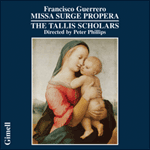Guerrero’s
Missa Surge propera is the only one of his eighteen settings to be scored for six voices; all the others are for fewer. Its model has not been identified, but it certainly is not the motet
Surge propera, which inhabits a quite different sound-world. The Mass has a sweep of phrase which may remind the listener of some of his Marian motets –
Maria Magdalene immediately comes to mind. The polyphony seems to glow with an inner sonority, yet the melodic lines are always grateful to sing, the classic shape of them often anticipating later writing. One might use words of this kind about much of Palestrina’s music, but there should be no confusion. Guerrero’s underlying harmonic sense is so strong that he hardly ever needs to resort to block chords, instead always keeping some sense of independent movement alive between the voices, even when setting a long text in an economical way (as in this Credo). The beauty is in the stability which the harmony brings, coupled to the easy flow of the melodic ideas as they move between the contributing voices. In this Mass Guerrero favoured full textures more than was usual for him, and also liked to group the three higher voices against the three lower ones, as at the beginnings of the ‘Christe eleison’, the ‘Qui tollis’ and the ‘Agnus Dei’. The
Missa Surge propera was published in Guerrero’s
Missarum Liber Secundus, in Rome in 1582.
from notes by Peter Phillips © 2005
Des dix-huit messes de Guerrero, la
Missa Surge propera est la seule à avoir été écrite pour six voix – toutes les autres s’adressent à un effectif plus réduit. Son modèle reste à identifier, mais ce n’est certainement pas le motet
Surge propera, à l’univers sonore bien différent. L’étendue de phrase de cette messe n’est pas sans rappeler à l’auditeur certains motets marials du compositeur –
Maria Magdalene nous vient tout de suite à l’esprit. La polyphonie semble briller d’une sonorité intérieure; pourtant, les lignes mélodiques sont toujours gratifiantes à chanter, leur forme classique anticipant souvent une écriture plus tardive. On pourrait dire la même chose pour une grande partie de la musique palestrinenne, mais il ne saurait y avoir de confusion. Guerrero a un sens harmonique sous-jacente si fort qu’il n’a presque jamais besoin de recourir à des blocs d’accords: il garde toujours vivace un mouvement indépendant entre les voix, et ce même lorsqu’il met en musique un long texte avec économie (comme dans ce Credo). La beauté réside dans la stabilité qui découle de l’harmonie, couplée au flux aisé des idées mélodiques se mouvant entre les voix en action. Dans cette messe, Guerrero a, plus que de coutume, préféré les textures complètes; il s’est plu à regrouper les trois voix supérieures contre les trois voix inférieures, comme au début des «Christe eleison», «Qui tollis» et «Agnus Dei». La
Missa Surge propera fut d’abord publiée dans le
Missarum Liber Secundus de Guerrero (Rome, 1582).
extrait des notes rédigées par Peter Phillips © 2005
Français: Gimell
Guerreros
Missa Surge propera ist die einzige seiner achtzehn Messvertonungen, die für sechs Stimmen angelegt ist; alle anderen sind für weniger Stimmen komponiert. Das Vorbild für diese Messe ist bisher noch nicht identifiziert worden und es ist mit Sicherheit nicht die Motette
Surge propera, da sie einer völlig anderen Klangwelt entstammt. In der Messe sind gewisse Bögen erkennbar, die den Hörer an einige seiner Marianischen Motetten erinnern mögen – so muss man etwa sofort an
Maria Magdalene denken. Die Polyphonie scheint dank einer inneren Klangfülle zu leuchten, und gleichzeitig sind die Melodie-Linien – deren klassische Form oft spätere Kompositionen antizipiert – für die Sänger stets dankbar gesetzt. Man könnte die Werke Palestrinas mit ähnlichen Worten beschreiben, doch sollte es da keine Verwechslungen geben. Das harmonische Fundament bei Guerrero ist so ausgeprägt, dass er fast nie auf Akkordblöcke zurückgreifen muss sondern stattdessen zwischen den Stimmen eine gewisse Unabhängigkeit aufrechterhalten kann, selbst wenn er einen langen Text auf relativ sparsame Weise vertont (wie in diesem Credo). Die Besonderheit liegt in der Stabilität der Harmonie und dem unbeschwerten Fließen des melodischen Materials, das sich zwischen verschiedenen Stimmen hin und her bewegt. In dieser Messe arbeitet Guerrero mit vollen Strukturen und Texturen, was für ihn eher untypisch ist; außerdem setzt er die drei höheren Stimmen gegen die drei tieferen Stimmen, etwa zu Beginn des „Christe eleison“, des „Qui tollis“ sowie des „Agnus Dei“. Die
Missa Surge propera wurde 1582 in Rom als Teil von Guerreros
Missarum Liber Secundus herausgegeben.
aus dem Begleittext von Peter Phillips © 2005
Deutsch: Viola Scheffel


 Guerrero: Missa Surge propera & motets
Guerrero: Missa Surge propera & motets
